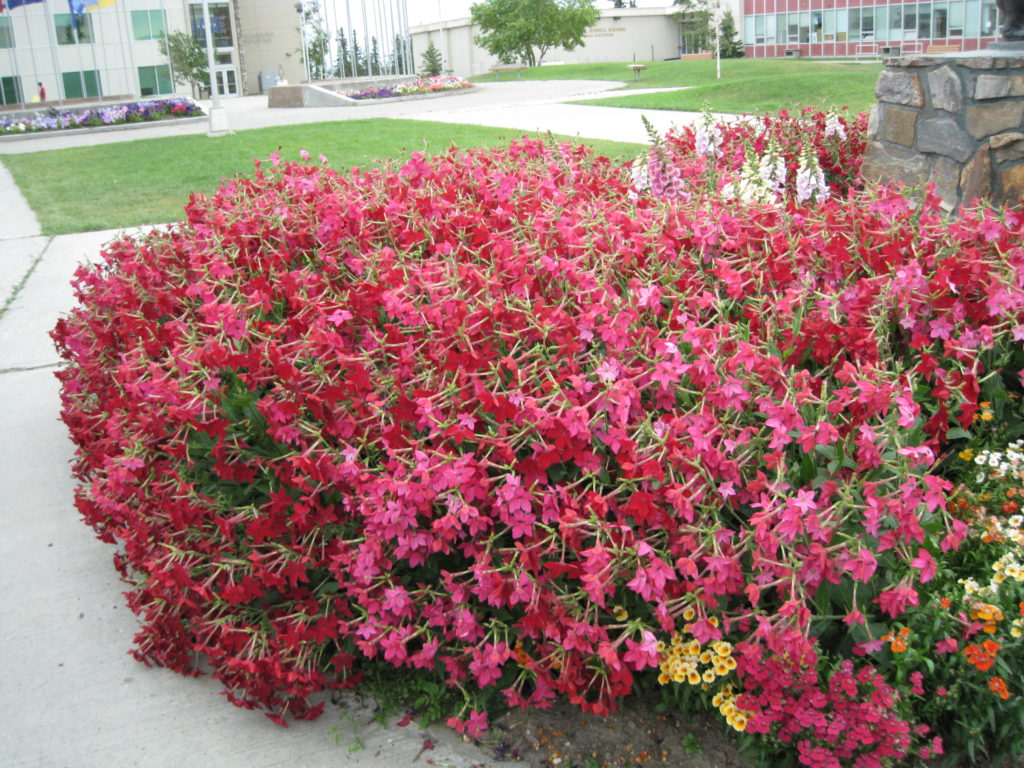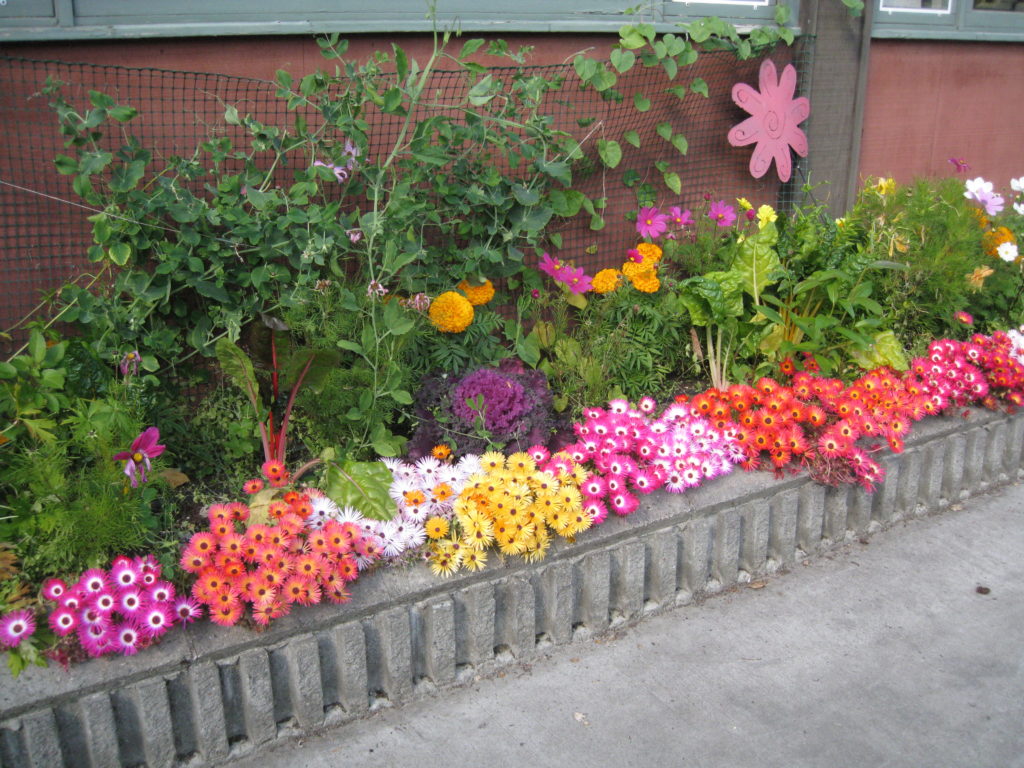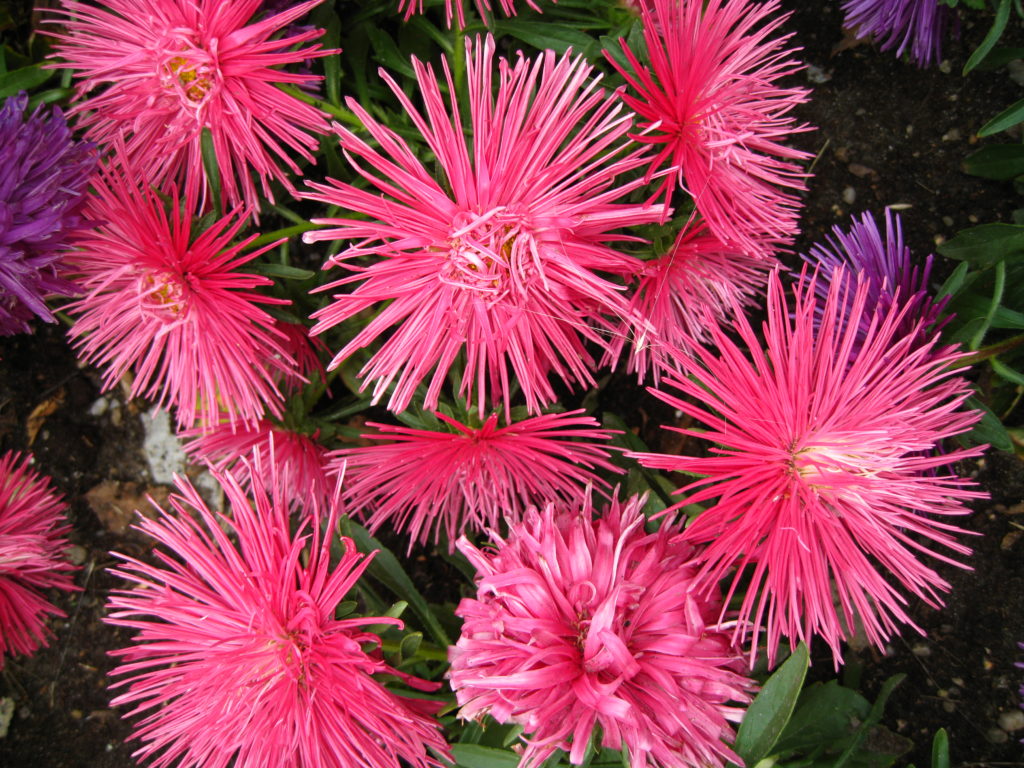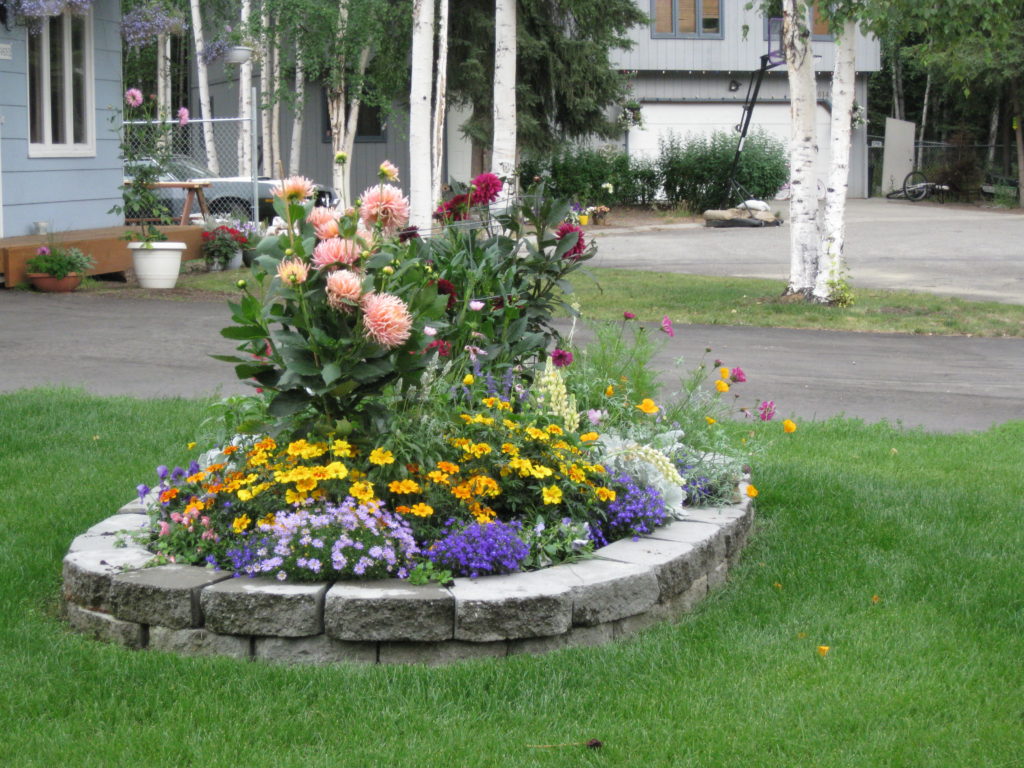As some of you might have deduced from reading this blog, I’m a die-hard edible gardener and it’s a stretch for me to think outside the vegetable row. If you can’t eat it and it doesn’t attract pollinators or fix nitrogen, it’s usually not going to get a spot in my garden. This summer, I decided to change that and dedicate one bed to flowers. Here’s how I designed it.
First, I needed to determine what I liked and didn’t like. As a starting point, I glanced through books and magazines, online, and through my many photos of flower beds taken at the Georgeson Botanical Garden on the Troth Yeddha’ campus, and at local hotels, greenhouses and home landscapes. I’m a garden nerd, and so I take a lot of photos of flowers, vegetables and gardens.
One of my favorite beds on campus uses the massing approach, where only one type of flower or plant in one or two shades is grown. This bed is a mass of crimson and strawberry-colored Nicotiana. It creates a dramatic visual impact. I’m not so into the beds on campus that are white and baby pink alyssum, a so-called restful combination.

These Nicotiana have taken over this garden bed and are a good example of a massing technique.
In addition to the overall bed design, I needed to think about color, texture, flower shape, height, focal points, bloom sequence and whether to integrate flowers, shrubs, herbs, vegetables and grasses. And finally, would the plants I chose thrive in Fairbanks?
From looking at other flower beds, I figured out that for colors, I like the maximum amount of contrast. Give me a bright pink cosmos with dark blue iris (or blue sage) or bright orange marigolds with dark blue lobelia. In There’s a Moose in My Garden, Brenda Adams calls this a “sassy’ combination. On the color wheel, this translates to a complementary or split complementary color scheme. I’m not so drawn to monochromatic, washed-out colors. This handy color wheel calculator helped further identify color schemes I liked. Cornell University also has some helpful guides for using color to design flower beds and more.

A very colorful garden bed that integrates flowers and vegetables is a beautiful and practical way to grow food and ornamentals in limited space. In front are Livingston daisies, Harlequin mix.
I also like varied and dramatic textures like grass or globe onions or coleus combined with flowers. And I like unique, oddly shaped flowers like hibiscus, Chinese asters, double poppies and clematis, not only because they photograph well. I’ll blame it on being a lifetime Fairbanksan, but I’m a little bored with petunias, lobelia, geraniums, begonias and pansies, even though I know they’re dependable.

These Chinese asters offer an interesting texture and vibrant color.
Variation in height also makes a flower bed more interesting. Standard advice says tall plants go in the back and short plants go in front to prevent shading and so you can see the short plants. A focal point might also be nice – this could be a tall plant, sculpture or birdbath, for example.

Mixing tall, medium and short or cascading flowers is a great way to create a visually dynamic bed.
Familiarizing myself with the ultimate height and bloom or maturity time helped me plan for what the bed would look like in a month or two and not focus on what it looks like now. I wanted at least something to be blooming throughout the summer. Perennials are nice because they come back every year but their flowers tend to be less showy and the bloom time shorter than annuals. Aside from length of bloom, flowers also start blooming either early, midsummer or late summer. I chose both perennials and annuals in my bed.
I do like the juxtaposition of flowers, shrubs, herbs, vegetables and grasses, but my bed is pretty small so I planted mostly flowers.
Unfortunately, not everything I wanted in my flower bed would thrive and bloom in Fairbanks’ short, sometimes hot, sometimes not, summers. The following resources can help you determine if something is a wise choice for Fairbanks:
- Flower trials conducted in Fairbanks at the Georgeson Botanical Garden
- The Georgeson Botanical Garden, UAF campus, local greenhouses, the Tanana Valley Fair Gardens, hotels, restaurants’ and friends’ gardens. Observe what thrives and what doesn’t and what you like and dislike.
Here are some other resources for determining what will grow best across Alaska:
- Alaska’s Sustainable Gardening Handbook, available from UAF Cooperative Extension Service
- Landscape Plants for Alaska
And finally, here are some national resources:
- Cornell National Herbaceous Perennial Database
- Missouri Botanical Garden Plant Finder
- The Best Plants For 30 Tough Sites, Minnesota Extension
After I had a sense of what I wanted to plant, then I needed to decide how they should be arranged. I was going for an aesthetic look so I didn’t simply want to line them up like in my vegetable garden. Looking at garden bed designs online helped give me creative ideas for arranging the plants. They used a square foot grid pattern to show the size of the bed and used coded shapes to show where each type of flower, and how many of that type of flower or plant to add to the bed. This was nice because it helped me envision what the bed would look like when it was mature. It also took the guesswork out of where I should put what and how far apart. I wanted a filled-in look, but didn’t want things to be too crowded.
Much like a recipe, I ended up making lots of substitutions based on my other design choices, what I knew would actually grow in Fairbanks (these designs were for the Lower 48), and what I could find at my local greenhouse. Another tip I came across was to plant a minimum of three of something, either clumped together or arranged throughout the bed, although I’ve seen many plans where this rule was not followed, particularly with perennials, since they tend to spread vegetatively, this probably isn’t necessary.
So what do you find attractive? If you’re not sure, start looking around to see what strikes your fancy and let the journey begin.
Previously published in the Fairbanks Daily Newsminer May 26, 2019.